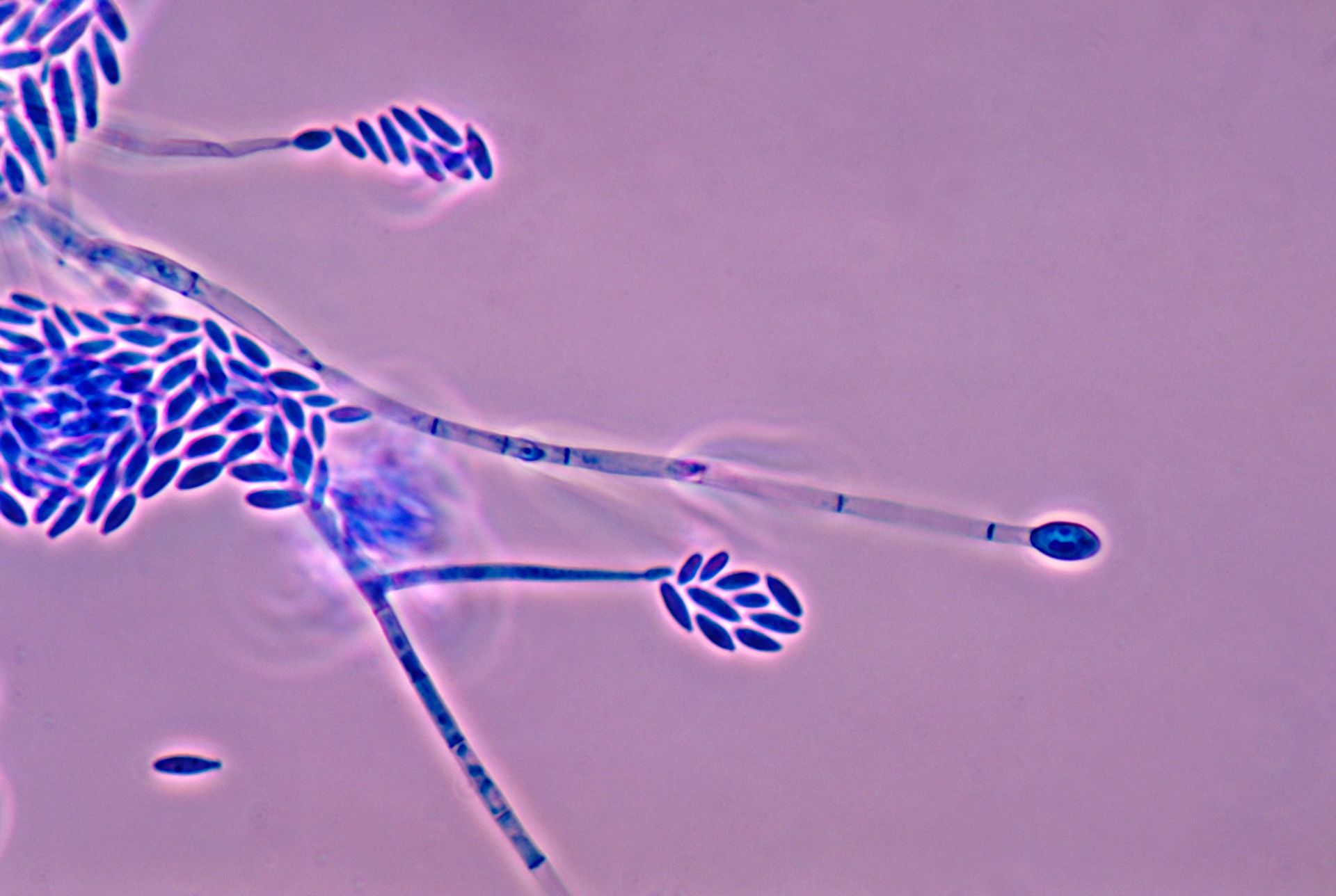Fusarium is a filamentous fungus found on plants and in soils. Fusarium has also been identified in both indoor and outdoor air samples. However, the species of Fusarium were not identified (Gorny & Dutkiewicz, 2002. Shelton et al, 2002; Tuomi et al, 2000).
The genus is not included in the U.S. EPA ERMI test.
The genus is part of the mycoflora of commodities, e.g., corn, rice, beans, soybeans, etc.
Infections have reported in immunocompetent individuals that include keratitis of the cornea, onchymycosis; cutaneous lesions and maxillary sinusitis (Anandi et al, 1992; Dignani and Anaissie, 2004).
For the most part, Fusarium species are opportunistic, causing infections via injury to the skin (puncture, abrasions) in burn patients and in immunosuppressed individuals, (e.g., cancer and organ transplant) otherwise called nosocomial infections. The species identified in nosocomial infections include solani, oxysporum, moniliforme, verticillioides, prolifertatum, dimerum, semitectum and sequiseti (Gupta and Summerbell, 2000; Nucci et al, 2002).
An outbreak of keratitis resulted from contaminated contact lens (Bullock, 2009).
Fusarium species produce several mycotoxins. These will be listed below along with their toxic effects on cells, animals and humans. Mononocyclic trichothecenes were detected in water-damaged building materials, presumably produced by Fusarium species. These include: diacetpxyscirpenol (DAS), deoxynivalenol (DON), 3-acetyl DON, T-2 tetraol (verrucarol) and T-2 toxin (Tuomi et al , 2000).
The mycotoxins produced by species of Fusarium will be listed below.
Two published reviews are:
Glenn AE. 2007. Mycotoxigenic Fusarium species in animal feeds. Animal Feed Sci Technol 137:213-40.
Nelson PE, Dgnani MC, Anaissie EJ. 1994. Taxonomy, biology and clinical aspects of Fusarium species. Clin Microbiol Rev 7:479-504. Read the full paper.
Fumonisins
Fumonisins (B1, B2 and B3)are potent inhibitors of of the mammalian acyl Co A dependent ceramide synthase, interfering with sphingolipid metabolism. The species producing these mycotoxins are verticillioides, proliferatum, fujikuroi, globosum, napiforme, nygamai and pseudonygamai. (Glenn 2007).
Nelson (1993) summarizes the health effects of fumonisins resulting from eating contaminated corn as leukoencephalomalacia in horses, pulmonary edema in swine and high rates of human esophageal cancer in Southern Africa.
Trichothecenes
Fusarium species produce non-macrocyclic trichothecenes. These include DON, DA S, 3-Ace-DON, T-2 Tetraol, verrucarol and T-2 toxin (Tuomi et al, 2000; Glenn 2007). They have been reported in building materials from water-damaged buildings (Tuomi 2000).
Trichothecenes are potent inhibitors of protein synthesis via binding to ribosomes and inhibition of pepidyltransferase. The species known to produce non-cyclic trichothecenes are grarnineanirmr pseudograniminearum, crookzellense (cerealis), culmorunir poaer sporotrichioidesr kyushuenser and langesthiae.
Bennet et al (1994) and Bennet and Lich (2003) summarize the toxicity of trichothecenes in animals and humans.
Trichothecenes are potent inhibitors of protein synthesis, therefore, affecting every major organ of the body. They are immunosuppressive and cause a wide range of gastrointestinal, dermatological and neurological symptoms.
During WW II, Russian people who had eaten contaminated grain developed a condition referred to as alimentary toxic aleukia (ATA).
In Japan, an illness called red mold disease (Akakbi-byo toxicosis) has been associated with consumption of contaminated grains.
Urov or Kashin-Beck disease that occurs endemically in in Cossacks, Eastern Siberia, Northern Korea and Northern China is a chronic disabling, deforming, dystrophic osteoarthosis involving the joints and spine.
ATA is divided into three clinical stages (see Nelson et al, 1994):
1. First Stage: Occurs 3-9 days after ingestion of contaminated grain. Symptoms are burning sensation in mouth cavity (tongue, throat, palate, esophagus) and stomach. Inflammation of stomach and intestinal mucosa leads to vomiting, diarrhea and abdominal pain. Excessive salivation, headache, dizziness weakness, fatigue and tachycardia. Fever may occur.
2. Second Stage: This is often referred to as the latent phase. The individual usually feels well and is capable of normal activity. Progressive disturbances in the hematopoietic system characterized by leukopenia (granulocytopenia) with mild lymphocytosis and anemia associated with decreased resistance to bacterial infections. This lasts from 3-4, and up to 8, weeks.
3. Third Stage: In this stage, petechial hemorrhages occur on the skin of the trunk and axillary and in inguinal areas, as well as on the arms, thighs and chest and, in some cases, the face. Necrotic lesions in the throat make it difficult to swallow. Secondary bacterial infections often occur because of depression of the immune system. The infections may result in death.
Zearalenone
Zearalenone is produced by the following species graminearunir cuirnorwm equiseti and crookzeilense.
Zeralenone is a reproductive (estrogenic) disruptor in humans and animals.
Commercial formulations were marketed as an anabolic agent for both sheep and cattle to treat post menopausal syndrome, and has been patented as an oral contraceptive.
It also disrupts spermatogenesis in male animals.
In Puerto Rico, it is believed to cause early menarche via dietary exposure.
Estrogenic effects in animals include infertility, vulva edema, vaginal prolapse, mammary hypertrophy in females and feminization in males. (Bennett & Klich, 2003; Peraica et al 1999).
Additional Mycotoxins of Fusarium
Other mycotoxins produced by Fusarium species include fusarin, moniliformin, fusaproliferin, enniatins and beauvericin. These are associated with contaminated grains. (Jestoi M. 2008).

